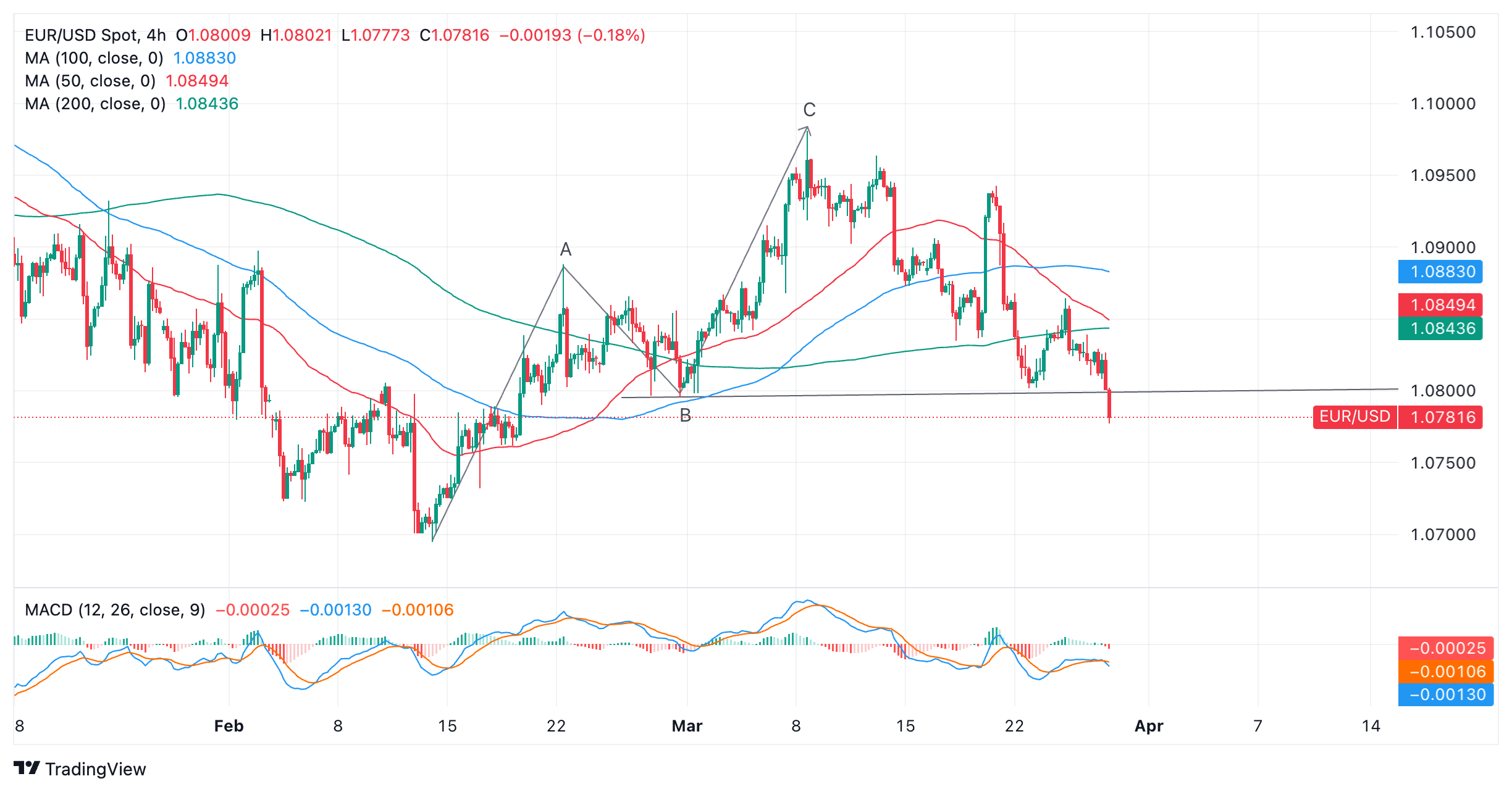- EUR/USD takes another step lower on poor German Retail Sales data.
- Subdued consumer spending levels in Germany increase the probability the ECB will cut interest rates soon.
- This contrasts with the US, where Fed officials are advocating a delay in rate cuts.
EUR/USD sells off on Thursday, breaking below key support at 1.0800 after the release of subpar German Retail Sales data raised further concerns over the health of Europe’s largest economy, weighing on the Euro (EUR). The pair is also pressured lower by a backdrop of the Federal Reserve (Fed) increasingly looking like it will delay cutting interest rates in light of more robust economic data and stickier inflation.
EUR/USD downtrend continues on fears Fed could delay cuts
EUR/USD’s move down extends the short-term downtrend that started after the rollover from the March 8 highs in the 1.0980s. The main catalyst appears to be the diverging commentary from rate-setters at the US Federal Reserve (Fed) and European Central Bank (ECB).
Whilst at the beginning of March the ECB was signaling it would cut interest rates by June and the Fed potentially by as early as May, recent higher-than-expected US data and sticky inflation has led many Fed officials to question whether it may be too early to start cutting interest rates.
The view the Fed may keep interest rates higher for longer has supported the US Dollar (USD) because higher interest rates tend to attract more foreign capital inflows. This is bearish for EUR/USD, which measures the buying power of a single Euro in USD terms.
On Wednesday, Federal Reserve board member Christopher Waller added his voice to those advocating a delay, saying that “there is no rush to cut the policy rate,” in a speech to the Economic Club of New York, according to Reuters.
ECB officials, on the other hand, have cleaved increasingly to June. Eurozone economic data has been on the whole disappointing compared to US data, although persistently high wage inflation still concerns some policymakers.
EUR/USD took another step lower on Thursday after German Retail Sales in February showed shoppers on the whole tightening their purse strings. Weakening consumer spending is another sign inflation will come down further, prompting the ECB to cut interest rates.
Retail Sales fell 2.7% YoY in Germany, which was far below estimates of a 0.8% decline, according to data from Statistisches Bundesamt Deutschland. Month-on-month the 1.9% decrease must have come as a shock after economists predicted a 0.3% rise.
Friday’s US core Personal Consumption Expenditures (PCE) Price Index data for February – the Fed’s preferred gauge of inflation – is likely to be an even more important release for EUR/USD.
A higher-than-expected result could push even further back the time when the Fed is expected to cut interest rates, with negative consequences for the pair.
Tehniskā analīze: EUR/USD turpina samazināties
EUR/USD extends the dominant short-term downtrend that started at the March 8 high. It has now broken below key support at around 1.0800.

Eiro pret ASV dolāru: 4 stundu diagramma
The pair formed a three wave price pattern called a Measured Move back in February and early March and the low of wave B provided the underpinning for key support at just above 1.0800.
If the break in progress proves decisive it would signal a continuation of the downtrend even lower, to the next target at 1.0750, followed by the February lows at roughly 1.0700.
Izšķirošajam pārtraukumam ir raksturīga gara sarkana lāču svece, kas tīri izlaužas caur līmeni un aizveras tuvu zemajam līmenim, vai trīs sveces pēc kārtas, kas pārkāpj līmeni.
Alternatīvi, virzība virs 1.0950 līmeņa apšaubītu īstermiņa lejupslīdes pamatotību.
Euro BUJ
Eiro ir valūta 20 Eiropas Savienības valstīm, kas ietilpst eirozonā. Tā ir otrā visvairāk tirgotā valūta pasaulē aiz ASV dolāra. 2022. gadā tas veidoja 31% no visiem ārvalstu valūtas darījumiem, un vidējais dienas apgrozījums pārsniedza 2.2 triljonus USD dienā. EUR/USD ir pasaulē visvairāk tirgotais valūtu pāris, kas nodrošina aptuveni 30% atlaidi visiem darījumiem, kam seko EUR/JPY (4%), EUR/GBP (3%) un EUR/AUD (2%).
Eiropas Centrālā banka (ECB) Frankfurtē, Vācijā, ir eirozonas rezervju banka. ECB nosaka procentu likmes un pārvalda monetāro politiku. ECB galvenais uzdevums ir saglabāt cenu stabilitāti, kas nozīmē vai nu kontrolēt inflāciju, vai stimulēt izaugsmi. Tās galvenais instruments ir procentu likmju paaugstināšana vai pazemināšana. Salīdzinoši augstas procentu likmes vai cerības uz augstākām likmēm parasti nāks par labu eiro un otrādi. ECB padome pieņem monetārās politikas lēmumus sanāksmēs, kas notiek astoņas reizes gadā. Lēmumus pieņem eirozonas nacionālo banku vadītāji un seši pastāvīgie locekļi, tostarp ECB prezidente Kristīne Lagarda.
Eirozonas inflācijas dati, ko mēra ar saskaņoto patēriņa cenu indeksu (SPCI), ir svarīgs eiro ekonometrisks. Ja inflācija palielinās vairāk nekā gaidīts, it īpaši, ja tā pārsniedz ECB noteikto 2% mērķi, tas uzliek ECB pienākumu paaugstināt procentu likmes, lai to atkal kontrolētu. Salīdzinoši augstas procentu likmes, salīdzinot ar tā kolēģiem, parasti nāks par labu eiro, jo tas padara reģionu pievilcīgāku kā vietu globālajiem investoriem, kur novietot savu naudu.
Datu izlaidumi novērtē ekonomikas stāvokli un var ietekmēt eiro. Tādi rādītāji kā IKP, ražošanas un pakalpojumu PMI, nodarbinātības un patērētāju noskaņojuma aptaujas var ietekmēt vienotās valūtas virzību. Spēcīga ekonomika nāk par labu eiro. Tas ne tikai piesaista vairāk ārvalstu investīciju, bet arī var mudināt ECB noteikt procentu likmes, kas tieši stiprinās eiro. Pretējā gadījumā, ja ekonomikas dati būs vāji, eiro kurss, visticamāk, kritīsies. Ekonomiskie dati par četrām lielākajām eirozonas ekonomikām (Vācija, Francija, Itālija un Spānija) ir īpaši nozīmīgi, jo tās veido 75% no eirozonas ekonomikas.
Vēl viens nozīmīgs eiro datu izlaidums ir tirdzniecības bilance. Šis rādītājs mēra atšķirību starp to, ko valsts gūst no sava eksporta un to, ko tā tērē importam noteiktā laika posmā. Ja valsts ražo ļoti pieprasītu eksportu, tad tās valūtas vērtība palielināsies tikai no papildu pieprasījuma, ko radīs ārvalstu pircēji, kuri vēlas iegādāties šīs preces. Tāpēc pozitīva neto tirdzniecības bilance stiprina valūtu un otrādi negatīvu bilanci.
Source: https://www.fxstreet.com/news/eur-usd-pushes-lower-after-disappointing-german-retail-sale-202403280833